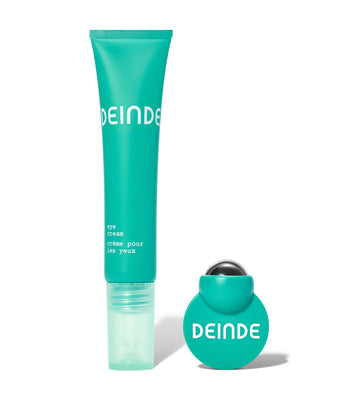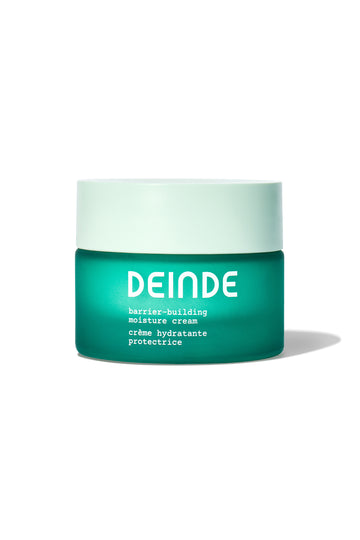
How To Get Clean and Clear Skin: 5 Tips for a Healthier Face
DEINDE is rooted in the concept that the steps we take today influence a better tomorrow. And skin? It’s no different. Every small action can play a role in determining the state of your complexion — great habits compound into healthy skin that reflects a well-balanced life.
While skin goes through various chapters, there are several basic foundational steps to take to ensure your skin is as healthy as can be. Remember that showing up for your skin is showing up for yourself.
1. Consistency is Key
Rome wasn’t built in a day. Neither were resilient skin barriers. Our skin is constantly exposed to damaging environmental factors like harmful microbes (bacteria, fungi, allergens), pollution, and harsh weather. Skin is a literal barrier between the body and the outside world. It’s essential to provide consistent support to our systems through protection and nourishment.
We see skin care as an investment that pays dividends in the form of improved skin texture, tone, and clarity. If you are consistently offering your skin products and support to prompt cellular turnover or relieve oxidative stress, your body will respond well with a clean and clear complexion.
At a minimum, we recommend the following skin practices on a daily basis. There’s beauty in simplified skincare processes, and it’s better to commit to a minimal, consistent routine rather than sporadically reaching for a mixed bag of products.
-
Cleanse: Daily removal of dirt, oil, and impurities with a gentle cleanser sets the stage for skin to fully benefit from additional product layering.
-
Moisturize: Hydration is a cornerstone for optimizing skin health. If skin exists in a dehydrated state, it will respond with flakiness, dryness, and increased oil production. Look for ingredients like niacinamide, peptides, and hyaluronic acid to nourish skin.
- Protect: Lock in previously used products and further protect the skin through consistent broad-spectrum sunscreen use. This should be essential in your skincare routine. Sunscreen not only reduces the risk of skin cancer but helps sustain skin by preventing premature aging signs like wrinkles and dark spots.
Note that exfoliating every so often helps remove dead skin cells, allowing fresh, healthy skin to surface. Just be careful not to over-exfoliate, as that can prompt irritation — especially if you have sensitive skin.
2. Interrupt Inflammaging
Inflammaging refers to the persistent state of immune activation. When the immune system is on high alert, it continuously releases pro-inflammatory molecules (cytokines and chemokines) that can disrupt basic skin functions. This low-grade chronic inflammation can generate oxidative stress, damaging cellular structures, and prompting accelerated aging.
Chronic, low-level inflammation doesn’t just impact the skin — it has been linked to a number of chronic diseases rooted in cellular damage. Interrupting inflammaging prevents the adverse effects of chronic inflammation on skin health, tissue integrity, and overall health.
Inflammaging can be interrupted through a number of lifestyle modifications and dietary interventions. Regular movement plays a role in reducing systemic inflammation, while skincare products rich in antioxidants like Naringenin, can support skin cell health during exposure to oxidative stress and promote skin rejuvenation.
3. Diet Matters
The phrase “you are what you eat” is a classic for a reason. Skin health and diet are intimately linked: the nutrients and bioactive compounds found in food can influence the skin’s appearance and functionality. For example, a diet rich in antioxidants can mitigate free radical damage by reducing oxidative stress.
Consuming ample fruits and vegetables over highly processed foods sets you up nicely to receive a variety of antioxidants, vitamins, and minerals. Diets high in sugary or processed foods can accelerate inflammaging by producing advanced glycation end products (AGEs), compounds created when sugar molecules bind to collagen and elastin. AGEs encourage an inflammatory response from the body, activating pro-inflammatory molecules like TNF-α and IL-6. The molecules are key mediators of the inflammatory response. When activated, they promote the production and release of other inflammatory molecules, which can prompt aging-related changes like visual skin aging (wrinkles, discoloration, blemishes, etc.), metabolic disorders, and cardiovascular diseases.
Eating deeply hydrating foods and ensuring your body is receiving ample water daily is pivotal for a balanced skin ecosystem. Water is not only vital for maintaining skin’s moisture balance, but for facilitating the transport of nutrients to skin cells and the removal of waste products.
4. Preventative Skincare is Key
It all comes back to inflammaging. Approaching anything with a preventative mindset helps frame how small steps, over time, lead to a compounding outcome. Consistently checking in with your skin and addressing future concerns, now, mitigates the effects of inflammaging and promotes healthier skin on a long-term basis.
For example, the impact of spending excessive time in the sun, without any SPF or protection, will build upon each other over the years, leading to damaged collagen and elastin fibers and an increased risk of skin cancer. Emotional stress that is not treated through shifts in lifestyle will compound over time and result in high levels of cortisol, accelerated visual aging, and impaired wound healing.
While band-aid solutions to skincare work in the short-term, a cadence of addressing common skin concerns like inflammation and dehydration trains the skin to build resilience, rather than existing in a fight or flight mentality.
5. Don't Overcomplicate It
There is an elegance to approaching anything with a minimal, simplistic mindset. Less can be more. Many people tend to overcomplicate their skincare routines due to the overwhelming number of products available, stepping into the mindset that more is better.
A simplistic, yet targeted skincare routine reduces the risk of overloading your skin with cosmetic active ingredients that may not work well together. The result is less irritation and breakouts, and an understanding of what formulations truly benefit your skin. Incorporating only a few key products well-suited to your skin type, concern, and goals ensures that your body is not constantly adapting to the introduction of new products.
A Note on Genetics
Prior to jumping into any guidance on achieving clean and clear skin, it’s important to recognize that our skin is the product of genetics, our environment, and the life we live. While we can alter some elements in this trio, skin is truly based on an individual's genetic makeup.
Skin type is hereditary. This is due to genetic variations that impact the production and regulation of sebum, the oily substance that plays a role in maintaining hydration levels and protecting the skin against pathogens. High sebum production can cause oily skin, while low levels lead to dry skin. Other common genetic factors that determine skin types include melanin production (skin color) as well as collagen and elastin production (key to elasticity and aging).
How can you Identify Your Skin Type?
Understanding the unseen forces behind your skin may bring some peace of mind if you suffer from excessively oily skin or can’t seem to keep moisture contained. As a reminder, these are key indicators of the most common skin types:
→ Dry Skin
Appears rough, flaky, and can be prone to redness or irritation. May lack a natural glow with visible fine lines and cracks. Feels rough, tight, and itchy. Dry skin can be triggered by exposure to harsh weather, excessive bathing, overuse of products, and dehydration. Gene variations can lead to a lack of natural skin oils and impaired barrier integrity.
→ Oily
A shiny or greasy complexion with enlarged pores and susceptibility to breakouts or blackheads. The skin may feel slick with an eternal oily texture. Oily skin is highly influenced by genetics, hormonal imbalances, and overactive sebum glands.
→ Combination
Exhibits a combination of both dry and oily — with some skin appearing dry, flaky, or red, while other skin may be shiny with enlarged pores. This skin type can be influenced by genetics, hormones, skincare routines, dietary choices, and climate. Gene variations can lead to differing levels of sebum production in the face, resulting in a patchwork of skin types.
→ Normal
a balanced and healthy appearance that is typically well-moisturized and clean. Skin may feel supple and comfortable without feeling tight or itchy. Normal skin is resilient with an optimal balance of skin barrier function and oil production.
Understanding the genetic forces that shape our skin allows for informed decision-making when determining a skin care strategy. With a genetic perspective in mind, the following tips for achieving clean and clear skin should consider that all skin is different — and there’s something to varied approaches to caring for ourselves.
We’d love it if everyone took the time to understand the biological complexity of the skin and how our body responds to various stressors. This collective understanding — and curiosity — would make it clear that leading a healthy life informs the state of skin, regardless of genetic predisposition. Hydration, movement, ample sleep, reducing emotional stress, nourishing food. These small daily steps create supported skin that is resilient down the line. That’s the DEINDE philosophy.
Studies cited:
- Inflammaging and Immunosenescence as Part of Skin Aging—A Narrative Review | NCBI
- Diet and Skin Aging—From the Perspective of Food Nutrition | NCBI
- Molecular genetics of the skin: the implications of understanding | NCBI
- Understanding and treating various skin types: the Baumann Skin Type Indicator | NCBI

















